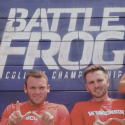UW-Madison students compete for national title in advertising competition
Finishing school, making rent, finding a first job, hanging out with friends — all top concerns of young adults.
Not typically high on the list: Buying insurance.
“Insurance is a really difficult thing to talk about to 18- to 25-year-olds,” says Peter Zook, who graduated from the University of Wisconsin–Madison last week with degrees in strategic communications and sociology. “One thing we found is that they’re just not thinking about insurance, so how do you get them to think about it?”
That was the challenge tackled by a group of 21 UW–Madison students, who developed an advertising campaign as part of a senior-level capstone class in the UW–Madison School of Journalism & Mass Communication that’s tied to the American Advertising Federation’s National Student Advertising Competition. State Farm Insurance provided the case study for this year’s contest: develop a strategic communications campaign designed to get young adults to purchase car and renter’s insurance.
The group took the regional title at a competition in Minneapolis in late April, besting seven other teams with their 20-minute presentation and 32-page casebook that details their whole campaign, how it will be executed creatively and how they would spend a hypothetical $40 million annual budget.
During the second week of June, the UW–Madison team will travel to Orlando, Fla., to compete for the national title against 18 other schools at the American Advertising Federation’s annual conference.
The emphasis of the class — and the competition — is gaining broad conceptual skills while preparing students for landing a first job after graduation, says Debra Pierce, faculty associate in the strategic communications area of the UW–Madison School of Journalism & Mass Communication.
Through the competition, students get real-world experience that mimics what life is like in an advertising agency, going beyond what they’d receive through internships, she says.
“They learn how to work under pressure, deliver a really good quality product, but work with a diverse team,” Pierce says. “They need to quickly get to know the case and each other to figure out how they can work well together. Part of the idea is to help them build their relationships and team-building skills. They would be working at an ad agency in similar conditions.”
Team members can’t talk about the specifics of their concept and campaign until after the national competition. Sharon Byer, a senior who graduated last week with a major in strategic communications and business certificate and who was an account director for the project, says the campaign is defined by a core theme that ties together all the elements — commercials, public relations, website and social media.
“Everything had a reason,” Byer says of the campaign. “There was a specific reason and that was to tie back to our campaign theme and our message. To me, that’s what made us stand out.”
Courtney Levy, a senior who graduated with a strategic communications major and business certificate and was an account director with Byer, said they also worked to balance the serious subject of insurance with some levity.
“We tried to use some humor and witty conversations to interact with people, trying to find the best way to catch their attention but also convey a message about something they don’t think about,” Levy says.
The work on the campaign began in the fall semester, when students received the assignment for the competition. Pierce led a group of strategic communications students in doing extensive marketing research and laying the groundwork for the advertising campaign that would be created in the spring semester.
In the spring, Pierce put together an interdisciplinary group — with students majoring in such areas as journalism, business, graphic design and communication arts — to essentially launch an advertising agency and develop a comprehensive ad campaign.
As the semester wore on, insurance took over the students’ lives. Zook says he was among those who immersed themselves in State Farm’s brand.
“I drilled pretty much everyone about their thoughts on insurance and State Farm,” he says. “If people ever had anything mean to say about State Farm, I took personal offense.”
UW-Madison last won the national competition in 2001, but has been a longtime contender and supporter of the program, Pierce says.
Competing on the national stage gives the students a chance to showcase their skills before a network of potential employers. The UW–Madison team members — many are still looking for jobs but plan careers in advertising — say they’re preparing for the opportunity to make connections that might jumpstart their careers.
In addition to the group’s comprehensive strategy, team members say the other key to their success has been their close-knit chemistry. The agency brand the team selected is Tandem Communications — working not only in tandem with their clients, but with each other.
The group didn’t proceed with an idea until everyone agreed, but getting to that point could sometimes be “painful,” Zook says. When the group was trying to figure out its print campaign, “we hit a lot of road bumps and were ready to turn back and start anew, but then it all clicked,” he adds.
Although the approach may have meant a longer process, Levy says, “in the end it gave us a much better creative strategy than we would have had.”


